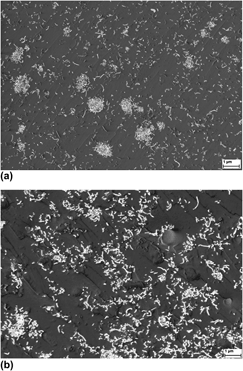Article contents
Effects of carbon nanotube fillers dispersion on mechanical behavior of phenolic/carbon nanotube nanocomposite
Published online by Cambridge University Press: 31 July 2012
Abstract

Systematic studies have been carried out for investigating the mechanical properties of carbon nanotube (CNT)-reinforced phenolic resin. In this work, phenolic resin/CNT nanocomposite were processed using two different techniques: (i) three-roll calender device (TRC) and (ii) aqueous solution processes. In both techniques, up to 2 wt% CNT was used. In this study, it was observed that the values of tensile strength, Young’s modulus, shear stress, impact resistance and also that of the tribological properties increased directly proportional to carbon nanotube volume content. Halpin-Tsai, Voigt-Reuss and Cox equations were adopted to fit the experimental data of the tensile strength and Young’s modulus of the multiwalled carbon nanotube/phenolic resin composite. Morphological analysis was done utilizing scanning electron microscopy (SEM) and good dispersion of nanotubes within the phenolic resin matrix was revealed. Also according to the results presented in this work, SEM showed that TRC processing gave better dispersion than aqueous solution mixing. The observation that the values for mechanical properties increased more for TRC than aqueous mixed samples is consistent with this.
Keywords
- Type
- Articles
- Information
- Copyright
- Copyright © Materials Research Society 2012
References
REFERENCES
- 10
- Cited by


